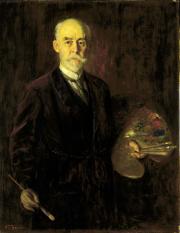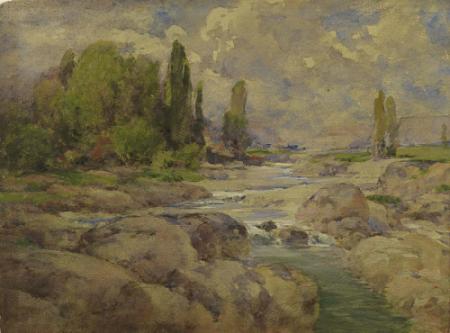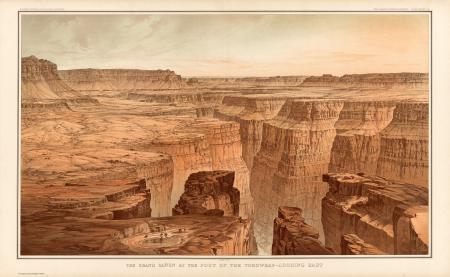 Shortly after the Smithsonian was founded in August of 1846, one of its most talented and prolific staff members, William Henry Holmes, was born in Cadiz, Ohio, on December 1. The youngest of three boys, William displayed his artistic talents early, but his father saw no future in such pursuits and steered him into teaching. After a few years teaching geography, natural history, and art, his father gave him $200 to further pursue his teacher training, but in 1870 the young Holmes took the money and ran – heading instead to Washington, D.C., to study art under a well-known teacher, Theodore Kaufmann. A fellow student, Mary Anna Henry, daughter of the first Smithsonian Secretary, Joseph Henry, encouraged him to visit the Castle to sketch the birds and other specimens on display. His work attracted the attention of the scientists there and soon he was hired by the paleontologist Fielding B. Meek to produce scientific illustrations. He had to learn to harness his artistic imagination and focus on accuracy and details, but his work soon passed muster with the Assistant Secretary in charge of the National Museum, Spencer F. Baird.
Shortly after the Smithsonian was founded in August of 1846, one of its most talented and prolific staff members, William Henry Holmes, was born in Cadiz, Ohio, on December 1. The youngest of three boys, William displayed his artistic talents early, but his father saw no future in such pursuits and steered him into teaching. After a few years teaching geography, natural history, and art, his father gave him $200 to further pursue his teacher training, but in 1870 the young Holmes took the money and ran – heading instead to Washington, D.C., to study art under a well-known teacher, Theodore Kaufmann. A fellow student, Mary Anna Henry, daughter of the first Smithsonian Secretary, Joseph Henry, encouraged him to visit the Castle to sketch the birds and other specimens on display. His work attracted the attention of the scientists there and soon he was hired by the paleontologist Fielding B. Meek to produce scientific illustrations. He had to learn to harness his artistic imagination and focus on accuracy and details, but his work soon passed muster with the Assistant Secretary in charge of the National Museum, Spencer F. Baird.


Holmes continued to refine his skills as an artist, sketching nearby and whenever he traveled. He joined art clubs and encouraged young artists. In 1920, he was named the inaugural director of the Smithsonian’s National Gallery of Art, getting the new museum up and running. Not a fan of modern art, he hoped the fad would soon pass in favor of styles like Thomas Moran and Frederick Church. After sixty years at the Smithsonian, he retired in 1932, and died the following year at his son’s home in Ohio.

Artist, scientific illustrator, geologist, archeologist, administrator, museum director – Holmes made a bewildering array of contributions to the early Smithsonian. He was born and grew with the Smithsonian. As new fields and opportunities appeared, his ever creative mind saw new possibilities and challenges, so he sought to meet them all. With his exceptional visual talents, Holmes was unique in the history of the Smithsonian in the breadth of his reach, spanning art, culture, and science but proving that one person can make contributions to them all.
Explore William Henry Holmes' field notes and sketches at the Smithsonian Transcription Center--and join other volunteers in transcribing!
Related Resources
Celebrating Our Man of Many Hats: William Henry Holmes, Smithsonian Libraries
Hair Today, Gone Tomorrow, SIRIS Blog
William Henry Holmes: Artist Biography, Smithsonian American Art Museum
Scientist of the Day: William Henry Holmes, Linda Hall Library
Produced by the Smithsonian Institution Archives. For copyright questions, please see the Terms of Use.


Leave a Comment